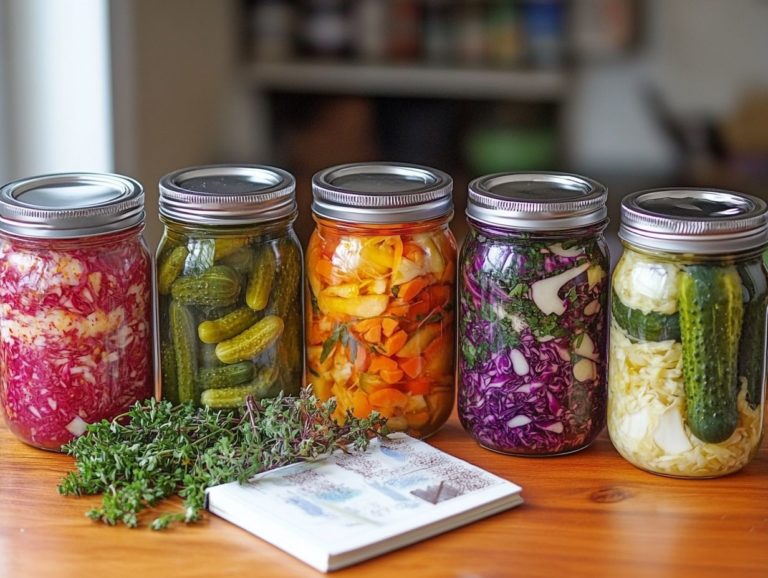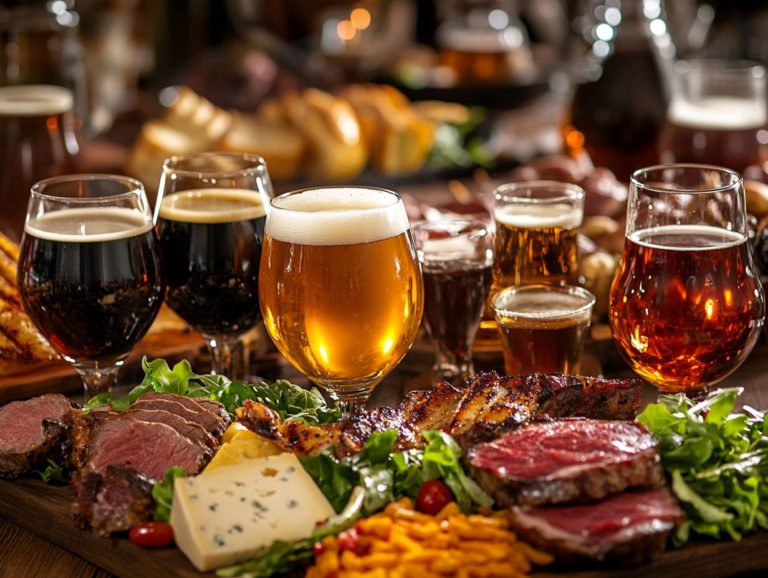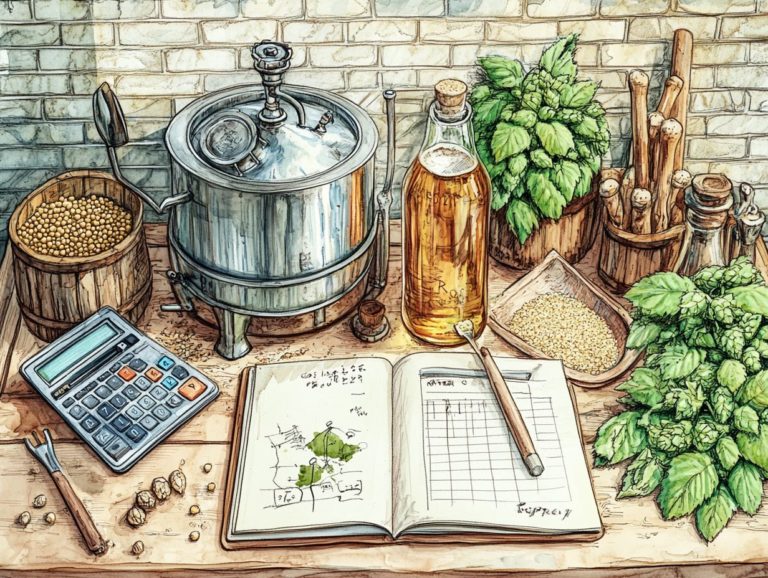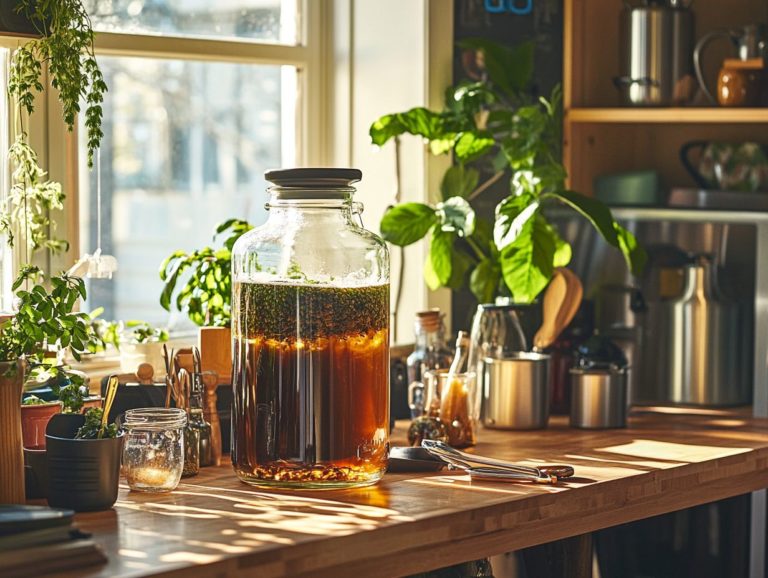Seasonal Brewing Tips for Every Home Brewer
Brewing seasonal beers offers you a delightful opportunity to celebrate the unique flavors and ingredients that each season, as outlined in the traditional brewing calendar, has to offer.
Incorporating seasonal elements into your craft can truly elevate your brewing experience and resonate deeply with your audience. From selecting fresh, local ingredients to experimenting with diverse spices and fine-tuning your brewing techniques, a wealth of creativity awaits your exploration, whether you’re preparing a summer ale or an Oktoberfest beer.
This guide provides you with essential tips and insights to help you fully embrace the spirit of the season in your brewing endeavors. Get excited to brew beers that not only taste amazing but also capture the spirit of every season!
Contents
- Seasonal Brewing Techniques
- 3. Adjust Brewing Techniques Based on Temperature
- 4. Consider the Seasonal Preferences of Your Target Audience
- 5. Use Fresh, Local Ingredients
- 6. Take Advantage of Seasonal Sales and Discounts
- 7. Incorporate Seasonal Themes into Labeling and Packaging
- 8. Plan Ahead for Seasonal Beers
- 9. Consider the Seasonal Availability of Certain Styles
- 10. Embrace the Spirit of the Season in Your Brewing Process
- Discover the Key Benefits of Seasonal Beer Brewing
- How Can Home Brewers Incorporate Seasonal Ingredients into Their Recipes?
- What Are Some Popular Seasonal Beers and Their Characteristics?
- How Can Home Brewers Stand Out in the Competitive Seasonal Market?
- What Are Some Tips for Pairing Seasonal Beers with Food?
- How Can Home Brewers Stay Creative and Innovative with Seasonal Beers?
- Frequently Asked Questions
- What are some tips for brewing in different seasons?
- How can I adjust my brewing process for the changing weather and seasons?
- What are some recommended ingredients and brewing tips for seasonal brewing?
- What should I keep in mind when brewing during the holidays like Christmas or St. Patrick s Day?
- Is there a specific type of beer or year-round beers that are better for certain seasons?
- How can I store my seasonal brews to ensure they last until the next season?
Key Takeaways

- Use seasonal ingredients to enhance the flavor and freshness of your beer.
- Experiment with different spices and flavors to create unique and seasonal brews, such as a pumpkin beer for fall or a Belgian ale for spring.
- Adjust your brewing techniques based on temperature to ensure the best results for your seasonal beer, whether you’re brewing in winter or spring.
1. Use Seasonal Ingredients
Utilizing seasonal ingredients in your brewing not only aligns your craft with the ebb and flow of the seasons, but it also elevates the flavor profiles of your beers. This makes them distinctly appealing to your audience. By focusing on fresh, locally sourced components, you can create a delightful array of seasonal beers that resonate with the traditional brewing calendar think of an Irish stout for St. Patrick’s Day or a refreshing summer ale to savor during those warmer months.
Insights from experts like David Ackley underscore the significance of these ingredients in making great beers that truly capture the essence of each season. Incorporating seasonal flavors, such as pumpkin in the fall or bright citrus in the spring, can dramatically influence both the taste and appeal of your creations.
Seasonal offerings, such as a bock beer for spring or a strong Scotch ale for winter, are often a magnet for both new and loyal customers, driving sales during peak times. Crafting a winter warmer infused with spices like cinnamon or ginger not only warms the palate but also encourages you to engage with community events that celebrate the season.
To effectively source local ingredients, consider cultivating relationships with farmers markets or local co-ops; this not only ensures freshness but also supports regional agriculture. Adapting your recipes to align with the seasonal availability of ingredients showcases your creativity and fosters a deeper connection between you and your craft, whether you’re brewing a pale ale or a dark beer.
2. Experiment with Different Spices and Flavors
Experimenting with a variety of spices and flavors can truly elevate your seasonal beers, enabling you to craft unique brews that distinguish themselves in the competitive craft beer landscape. Whether it’s a saison in the summer or a dopplebock in the winter, the possibilities are endless.
Incorporating spices like cinnamon, ginger, and coriander into your brewing recipes adds warmth and depth, especially as the colder months roll in. For instance, when you add a touch of cinnamon to a pumpkin beer in autumn, it infuses the beverage with a cozy nostalgia that drinkers are sure to appreciate.
Spiced winter ales or a hearty barleywine aging can benefit immensely from the zesty kick of ginger and the aromatic allure of coriander. To achieve optimal results, consider steeping these spices in the wort for a brief period. This allows the flavors to meld beautifully without becoming overwhelming.
Experiment with both the quantity and timing of your spices. This careful balancing act will ensure that each sip remains aromatic yet delightfully drinkable.
Seasonal Brewing Techniques
3. Adjust Brewing Techniques Based on Temperature
Adjusting your brewing techniques based on temperature is essential for crafting high-quality seasonal beers, whether it’s a pilsner in the heat of summer or an imperial stout in the cold of winter. Even slight temperature fluctuations can significantly impact fermentation and flavor development.
As a brewer, you’ll find that managing fermentation temperatures becomes especially critical when shifting from the brisk chill of winter to the warm embrace of summer. In the winter months, ensuring that your fermentation vessels are housed in a temperature-controlled environment is key to maintaining optimal yeast activity and avoiding unwelcome off-flavors that can arise from cold-stressed yeast. This is particularly important when brewing a hefeweizen in winter or an amber ale in summer.
During the sweltering summer heat, employing techniques like immersion cooling or utilizing temperature-controlled fermentation chambers can help you maintain a consistent environment. This ensures that your summer ales achieve that perfect crispness and refreshing character you aim for.
By mastering these seasonal adjustments, you not only refine your production time but also elevate the overall quality of your distinct beer styles, effectively showcasing the unique essence of each season.
4. Consider the Seasonal Preferences of Your Target Audience
Understanding the seasonal preferences of your target audience is key to crafting beers that entice their palates and align with their drinking habits throughout the year.
For instance, you ll find that many beer enthusiasts lean towards refreshing, light-colored ales during the warmer months, savoring the crisp notes and citrusy flavors that perfectly complement outdoor gatherings. However, as temperatures drop, preferences often transition towards richer selections, like imperial stouts and hearty porters, or perhaps a strong Scotch ale, which offer comforting warmth and complexity.
As a homebrewer aiming to cater to these distinct seasonal tastes, you can experiment with ingredient choices. Consider adding seasonal spices or varying malt profiles to create unique brews that truly resonate with consumers.
Use seasonal marketing ideas to enhance product visibility and generate excitement. Attract eager patrons who are ready to explore new flavors, such as a festive Christmas brew or an Irish stout for St. Patrick’s Day, as the seasons change.
5. Use Fresh, Local Ingredients
Using fresh, local ingredients not only elevates the quality of your seasonal beers but also supports local farmers and enhances the sustainability of your brewing process. This is a fundamental principle in home brewing that many traditional brewing institutes advocate for.
Incorporating locally sourced grains, hops, and adjuncts can dramatically transform the taste profile of your beer, offering unique flavors and aromas that simply can’t be matched by mass-produced options. For instance, specific varieties of hops cultivated in your region can impart distinct floral or citrus notes, enriching the overall drinking experience. This can make your homebrew ready for any competitive craft beer event.
When you experiment with nearby grain options, you not only increase freshness but also forge a meaningful connection with the local terroir (the unique characteristics of a specific region). To effectively integrate these ingredients, it s best to start by adjusting your brewing process to accommodate their unique characteristics and bring out their natural flavors. This approach is a game changer!
Crafting seasonally inspired recipes allows you to celebrate these local contributions, resulting in a brew that’s both approachable and delightful. Start your brewing adventure today with local ingredients and taste the difference!
6. Take Advantage of Seasonal Sales and Discounts
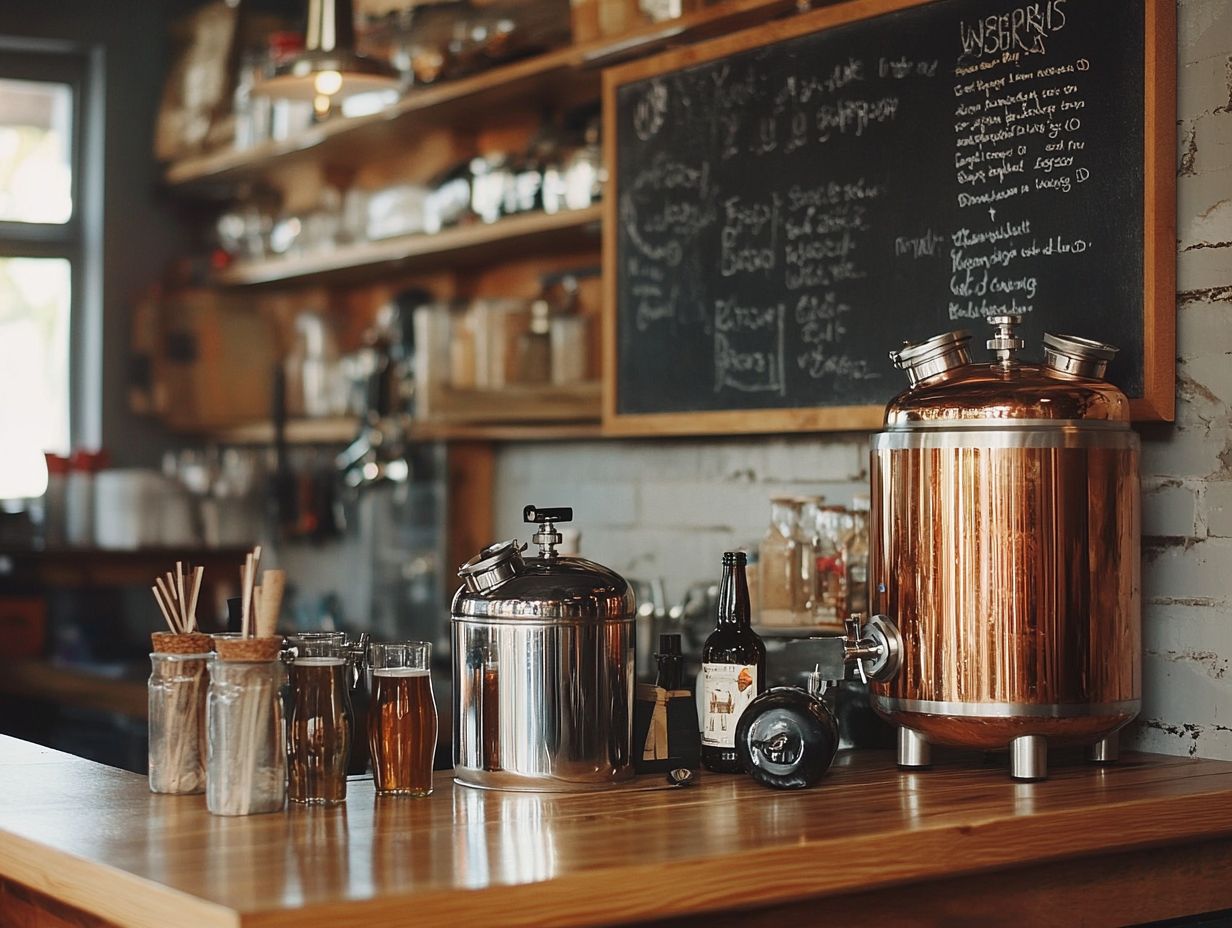
Taking advantage of seasonal sales and discounts can significantly enhance the profitability of your craft beer business while giving you the perfect opportunity to introduce new seasonal brews to your customers.
This strategy boosts revenue and creates great experiences for beer enthusiasts. They will be eager to explore unique flavors that capture the spirit of each season. For instance, implementing festive promotions during holidays such as Christmas or St. Patrick’s Day can attract crowds looking to celebrate with themed offerings. Consider using eye-catching packaging and organizing special tasting events to engage your customers fully. This works particularly well for seasonal beers like an Oktoberfestbier in the fall or a classic pale ale in the spring.
Leverage social media to showcase these limited-time offers and encourage sharing to amplify your reach. Don t miss the chance to create enticing bundles! Pair seasonal beers with festive snacks to attract more visitors and make every sip a celebration.
7. Incorporate Seasonal Themes into Labeling and Packaging
Incorporating seasonal themes into your labeling and packaging can create a distinctive identity for your seasonal beers, allowing you to capture the essence of each season while appealing to your customers emotions. Consider elements like the style of a Belgian pale ale or the traditions surrounding a gose.
By selecting bright and vibrant colors for your summer ales, you can evoke feelings of refreshment and warmth. In contrast, cozy and warm designs for your winter brews can stir nostalgia and comfort during those chilly months. These thoughtful design choices do more than just catch the eye; they enhance the overall drinking experience, making it memorable. For instance, a colorful label on a pale ale can give it a sense of summer fun, while a darker, richer design on an imperial stout can emphasize its depth and complexity.
Engaging with local beer blogs can significantly elevate your visibility within the craft beer community, as these platforms often offer valuable insights and foster strong connections with potential customers. These blogs are particularly useful for sharing brewing tips and seasonal recipes.
Crafting seasonal designs and collaborating with local influencers can be a powerful dual strategy to capture attention and cultivate loyalty among your audience. Whether you’re promoting a new saison or a classic brown ale, effective marketing can significantly enhance your reach.
8. Plan Ahead for Seasonal Beers
Planning ahead for seasonal beers is crucial for you to meet demand and deliver high-quality products that align with your audience’s expectations and preferences throughout the year. This includes scheduling enough production time for each unique brew, from barleywine aging to quick-turnaround pale ales.
To effectively leverage the brewing calendar, it’s essential that you create a timeline outlining each step of the brewing process, from initial recipe development to final packaging. Start by researching seasonal trends and popular flavors that resonate with specific holidays or seasons, giving yourself ample time for experimentation. Make sure to allocate sufficient resources and set realistic deadlines to avoid production bottlenecks. Additionally, consider brewing tips from experts like David Ackley to refine your process.
Consider collaborating with local suppliers to secure fresh ingredients, as this can significantly elevate the quality of your seasonal offerings. By meticulously managing every aspect of production, including production time, you can ensure that your beverages not only capture the spirit of each season but also delight customers who are eagerly anticipating timely releases.
9. Consider the Seasonal Availability of Certain Styles
Consider the seasonal availability of specific beer styles. This approach allows you to showcase the unique characteristics of each style at specific times of the year.
Understanding seasonal trends taps into the enthusiasm surrounding events and milestones. For instance, as spring approaches, bock beer invites drinkers to celebrate the warming weather.
The distinct taste of Irish stout is perfect for St. Patrick s Day, drawing in crowds eager to indulge in tradition. In winter, the robust profile of barleywine offers a comforting sip on chilly evenings.
Don t overlook Oktoberfestbier in the fall, which adds to the festive atmosphere.
Sourcing high-quality, seasonal ingredients like fresh hops and specialty malts enhances the overall quality of your offerings. This strategy builds a strong connection with customers.
It also creates excitement with limited-edition releases. This creates urgency, encouraging patrons to experience your latest seasonal creations before they run out.
10. Embrace the Spirit of the Season in Your Brewing Process
Embracing the spirit of the season in your brewing process not only enriches the flavors of your seasonal beers but also fosters a deeper connection with your consumers, reflecting the mood and traditions of each time of year.
Why not craft a robust Scotch ale? It s the perfect winter brew! This style of beer, known for its rich malt flavors and warming alcohol content, pairs beautifully with holiday gatherings and cozy evenings spent by the fire. You might also brew a strong Scotch ale for those who prefer more intense flavors.
As the warmth of summer approaches, think about designing light ales that embody the spirit of summer celebrations. These refreshing brews are ideal for outdoor barbecues and garden parties. Creating a summer ale is a perfect example.
Incorporate spices or seasonal fruits when brewing to create unique flavors. Picture adding cinnamon and vanilla to that winter brew or infusing citrusy hops into a summer ale.
Engaging with local ingredient suppliers enhances the authenticity of your creations and forges a stronger connection between your brand and the community s customs. Don t miss out on the chance to connect with local suppliers for better ingredients!
Discover the Key Benefits of Seasonal Beer Brewing
Brewing seasonal beers presents a wealth of advantages. It allows you to attract customers with fresh and exciting flavors. Additionally, it enhances your brewery’s reputation and aligns with market trends that celebrate unique offerings throughout the year.
By embracing changing seasons, you can create exciting and unique products that thrill your customers. This not only draws in new patrons but also builds loyalty among your existing customers, who eagerly anticipate these limited-edition releases. This sense of anticipation deepens their connection with your brand as enthusiasts gather to share their experiences and explore innovative flavor profiles. You might even find your efforts featured in a local beer blog.
Seasonal beers provide a great opportunity for creative expression. They enable you to experiment with ingredients and techniques that showcase local produce or pay homage to cultural celebrations. Such initiatives not only strengthen community ties but also play a crucial role in shaping your brewery’s identity, helping you establish a memorable presence in a competitive market.
How Can Home Brewers Incorporate Seasonal Ingredients into Their Recipes?
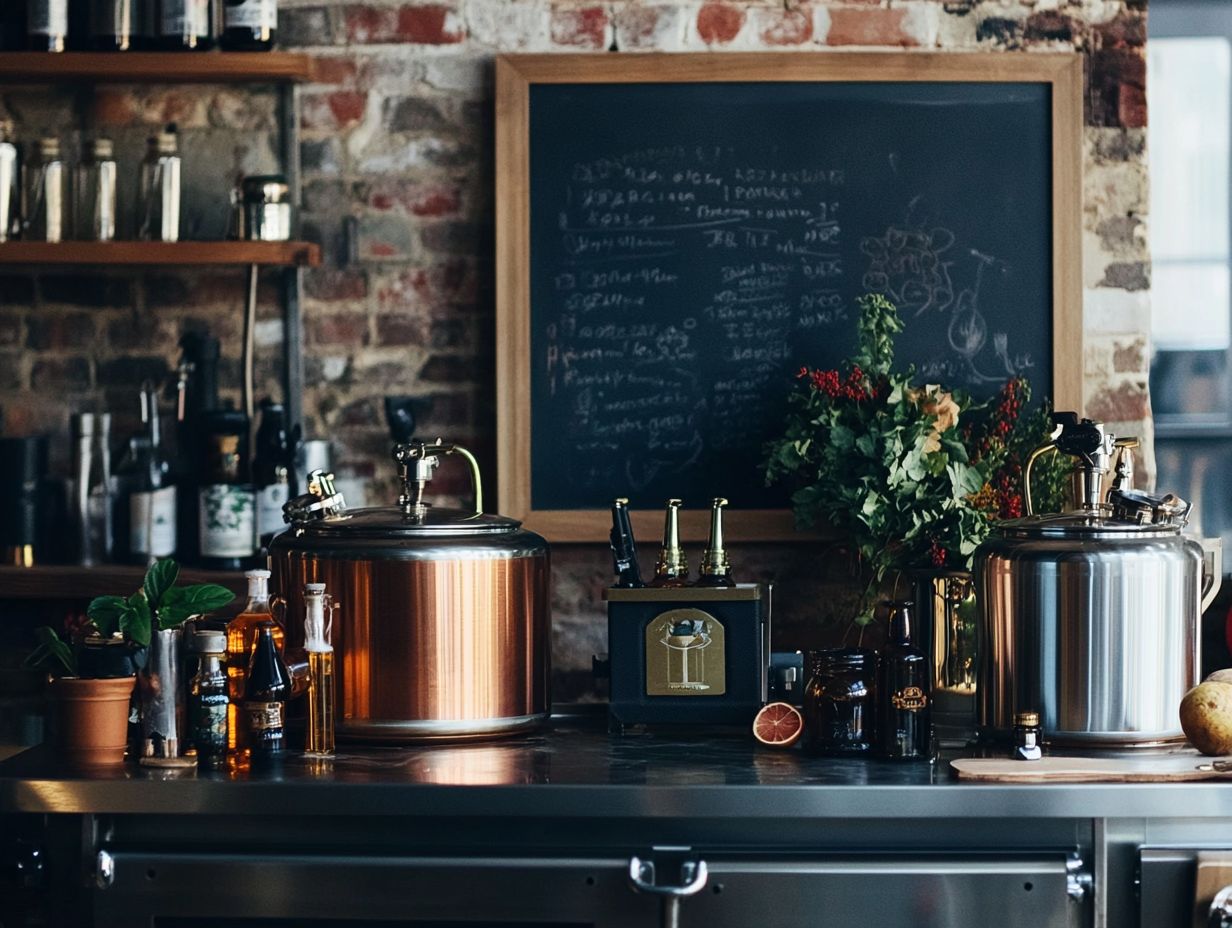
You can elevate your home brewing by incorporating seasonal ingredients into your recipes. Start by researching local harvests and adapting your brewing techniques to feature fresh produce, grains, and hops that capture the essence of each season. Engage with the Local Beer Blog community to get more ideas.
By tapping into local farmers’ markets or joining community-supported agriculture (CSA) programs, which connect you directly with local farms, you can discover unique options that enrich your brewing experience. Utilizing what’s in season not only supports local economies but also provides access to ingredients at their peak freshness, which can dramatically influence the final flavor profile of your beers.
For instance, consider infusing a summer ale with ripe peaches or adding floral hops during spring to create distinct flavors that truly resonate with the season. You could also explore Pale Ale variations for a different twist.
Exploring these recipes fosters creativity in your brewing while connecting you to the land, greatly enhancing your overall enjoyment of craft beer. Act fast to source these seasonal ingredients while they’re at their best!
As the seasons change, so do the beers we crave. Seasonal beers offer unique experiences that align perfectly with the time of year. Here s a look at some popular seasonal beers and tips for enjoying them to the fullest.
What Are Some Popular Seasonal Beers and Their Characteristics?
Some of the most beloved seasonal beers include summer ales, celebrated for their refreshing qualities; Irish stouts, which are a staple during St. Patrick s Day; and the robust bock beers that perfectly embody the spirit of spring. Each of these styles boasts unique characteristics that contribute to their widespread appeal.
Oktoberfestbier is essential in the fall, capturing the essence of the Oktoberfest celebration. Seasonal beers typically highlight flavors and aromas that reflect the time of year, enhancing your overall drinking experience.
Summer ales often present fruity notes, crisp finishes, and a light golden hue that beckons you to indulge on warm days. In contrast, the rich, creamy texture of Irish stouts, with their coffee or chocolate undertones, evokes a sense of warmth and comfort during the colder months.
As for bock beers, their deep amber color and malty sweetness align beautifully with the rejuvenation of spring. Don’t forget about the unique Gose style, which is a sour, salty beer originating from Germany, providing a tart and refreshing experience perfect for summer.
These distinctive qualities resonate powerfully with consumers, making seasonal marketing vital for breweries that aspire to cultivate anticipation and foster loyalty among their audience.
How Can Home Brewers Stand Out in the Competitive Seasonal Market?
To truly stand out in the competitive seasonal market, you must innovate your brewing techniques, experiment with unique ingredients, and craft engaging marketing strategies that showcase your distinctive seasonal beers.
Consider exploring creative flavor combinations imagine infusing traditional autumn ales with subtle hints of maple or crafting refreshing summer lagers with crisp slices of cucumber. Such adventurous pairings can undoubtedly attract curious palates eager for new experiences.
Delve into home brewing communities to gather and share ideas. Artistic packaging can make your beer irresistible! Opt for vibrant, seasonally-themed labels and eco-friendly materials that not only catch the eye on store shelves but also tell a compelling story behind each brew.
Engaging with local beer communities is equally vital. Host tasting events, conduct home-brewing workshops, or collaborate on special brews to strengthen connections and cultivate loyalty among your consumers.
In terms of promotion, leverage social media to showcase your seasonal offerings. Share captivating visuals, offer behind-the-scenes glimpses of your brewing processes, and highlight customer interactions to amplify your reach. This approach creates buzz and excitement that translates seamlessly into sales.
What Are Some Tips for Pairing Seasonal Beers with Food?
Pairing seasonal beers with food elevates your dining experience to new heights, as the flavors of the beer can beautifully complement or contrast with various dishes, crafting a memorable culinary journey.
Take autumn, for example. Imagine indulging in a rich imperial stout alongside a decadent chocolate dessert; the stout’s deep, roasted notes amplify the sweetness of the chocolate, creating a blissful harmony on your palate.
Now, when summer arrives, you can’t go wrong with a light and refreshing hefeweizen paired with crisp, colorful salads. Its fruity and citrus undertones will enhance the fresh flavors of the vegetables, making each bite a delight. Belgian ales, with their complex flavors, are also excellent for summer pairings.
Emphasizing the principles of food and beer pairing can also serve as your guiding star. Think about balancing lighter fare with zesty wheat beers or matching robust meals with stronger ales.
By grasping these dynamics, you can elevate your dining experiences and dive into a world of delightful flavor profiles. Consider attending workshops or seminars at the Brewing Institute for more insights on food and beer pairings.
Don t miss out on the opportunity to explore and experiment with seasonal brews. Dive into the world of seasonal beers today and discover your new favorite flavor!
How Can Home Brewers Stay Creative and Innovative with Seasonal Beers?
You can stay creative and innovative with your seasonal beers by continuously experimenting with new ingredients, techniques, and styles. This ensures your brewing process remains both exciting and fresh. Engage with the home brewing community to exchange ideas and receive feedback.
The changing seasons provide great inspiration. They encourage you to explore unique flavor combinations that capture the essence of each time of year. For example, incorporating warming spices like cinnamon and nutmeg during the fall can evoke those cozy feelings we all cherish. Meanwhile, refreshing citrus notes might be just what you need for your summer ale brews.
Gather feedback from family, friends, and local craft beer enthusiasts. This offers valuable insights that can guide you in refining your ideas or creating new recipes based on what resonates most with consumers. This collaborative approach stimulates innovation and cultivates a community, fostering a deeper connection to the art of brewing and home brewing.
For more brewing tips and techniques, visit the Brewing Institute or check out the Local Beer Blog.
Frequently Asked Questions
What are some tips for brewing in different seasons?
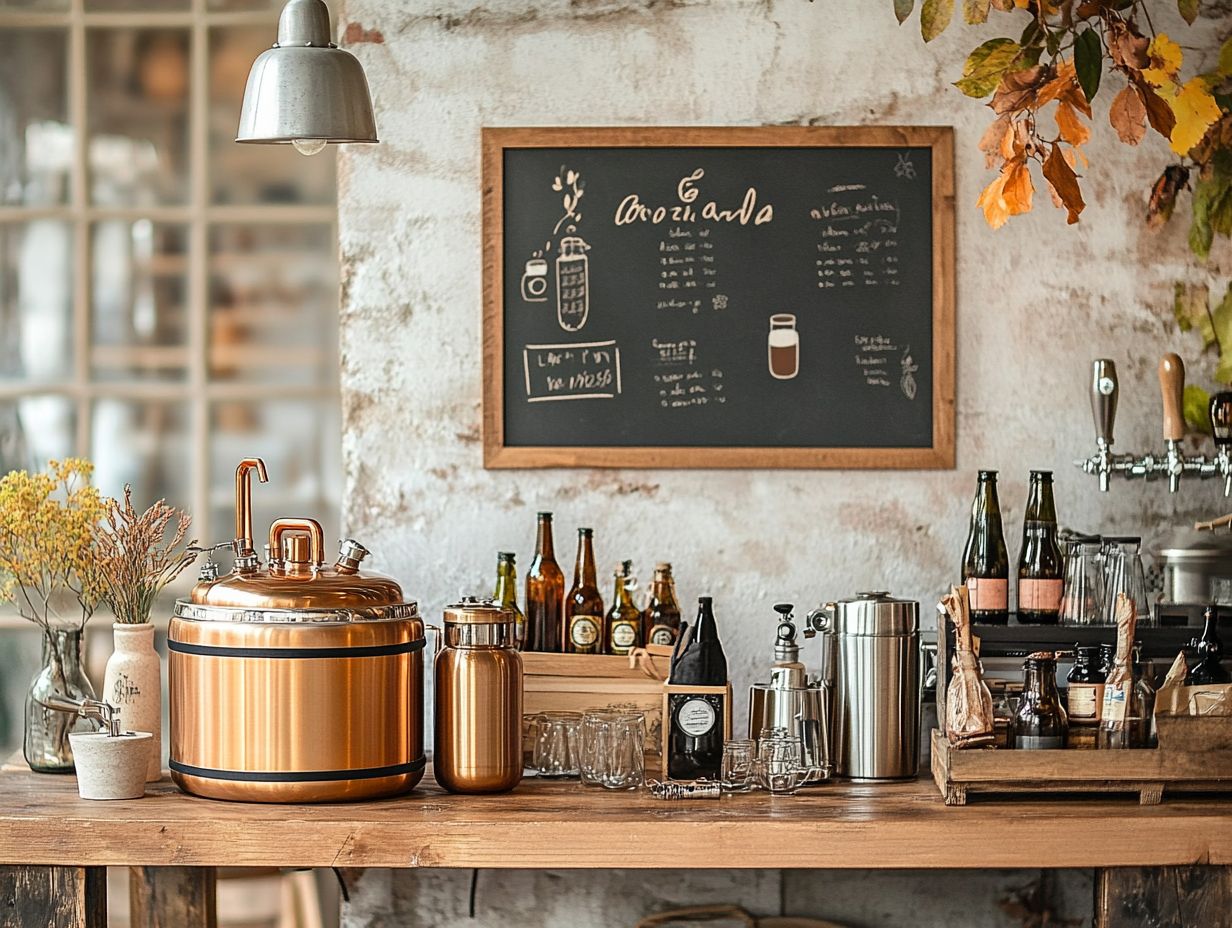
During the warmer months, try using lighter grains and hops to create a refreshing brew like a Pale Ale or Belgian ales. In the colder months, opt for darker grains and richer flavors to warm you up with brews like Imperial Stout or Irish Stout.
How can I adjust my brewing process for the changing weather and seasons?
In the summer, consider brewing in the morning or evening when temperatures are cooler. In the winter, brew indoors or invest in equipment that can regulate temperature. Be sure to follow a brewing calendar to make the most of every season!
What are some recommended ingredients and brewing tips for seasonal brewing?
For a summer brew, try using citrus fruits or lighter malts like pilsner or wheat. Consider making a Saison or a light colored ale. For a winter brew, experiment with spices like cinnamon, nutmeg, and cloves. Brews like Barleywine or Dopplebock are excellent choices.
What should I keep in mind when brewing during the holidays like Christmas or St. Patrick s Day?
Consider incorporating holiday flavors like pumpkin, cranberry, or gingerbread for your Pumpkin Beer or Belgian Pale Ales. Remember that many people are looking for heavier, richer beers like barleywine or strong Scotch ale during this time.
Is there a specific type of beer or year-round beers that are better for certain seasons?
While personal preference plays a big role, generally lighter beers like IPAs and Pilsners are better for summer while darker beers like stouts and porters are better for winter. For instance, a refreshing Hefeweizen works great for summer, and an Oktoberfestbier fits perfectly with autumn celebrations.
How can I store my seasonal brews to ensure they last until the next season?
Properly sealing and storing your beer in a cool, dark place can help prolong its shelf life. Consider investing in a temperature-controlled fridge or cellar for optimal storage. Techniques like barleywine aging (a process of storing strong beers to develop their flavors over time) can be very effective in preserving strong beers.

